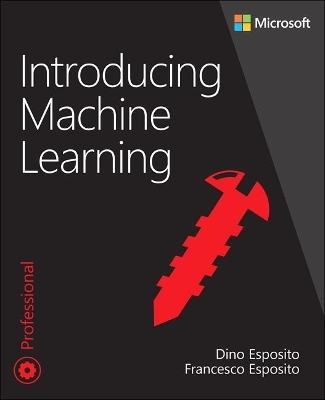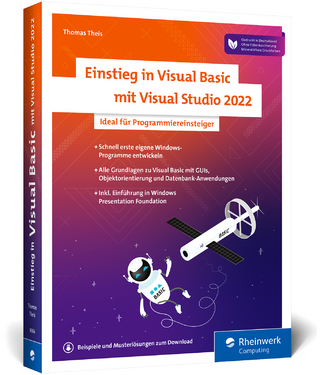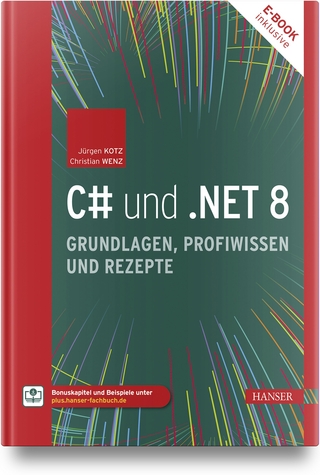
Introducing Machine Learning
Addison Wesley (Verlag)
978-0-13-556566-7 (ISBN)
Machine learning offers immense opportunities, and Introducing Machine Learning delivers practical knowledge to make the most of them. Dino and Francesco Esposito start with a quick overview of the foundations of artificial intelligence and the basic steps of any machine learning project. Next, they introduce Microsoft’s powerful ML.NET library, including capabilities for data processing, training, and evaluation. They present families of algorithms that can be trained to solve real-life problems, as well as deep learning techniques utilizing neural networks. The authors conclude by introducing valuable runtime services available through the Azure cloud platform and consider the long-term business vision for machine learning.
· 14-time Microsoft MVP Dino Esposito and Francesco Esposito help you
· Explore what’s known about how humans learn and how intelligent software is built
· Discover which problems machine learning can address
· Understand the machine learning pipeline: the steps leading to a deliverable model
· Use AutoML to automatically select the best pipeline for any problem and dataset
· Master ML.NET, implement its pipeline, and apply its tasks and algorithms
· Explore the mathematical foundations of machine learning
· Make predictions, improve decision-making, and apply probabilistic methods
· Group data via classification and clustering
· Learn the fundamentals of deep learning, including neural network design
· Leverage AI cloud services to build better real-world solutions faster
About This Book
· For professionals who want to build machine learning applications: both developers who need data science skills and data scientists who need relevant programming skills
· Includes examples of machine learning coding scenarios built using the ML.NET library
Dino Esposito: If I look back, I count more 20 books authored and 1000+ articles in a 25-year-long career. I’ve been writing the “Cutting Edge” column for MSDN Magazine month after month for 22 consecutive years. It is commonly recognized that such books and articles have helped the professional growth of thousands of .NET and ASP.NET developers and software architects worldwide. After I escaped a dreadful COBOL project, in 1992 I started as a C developer, and since then, I have witnessed MFC and ATL, COM and DCOM, the debut of .NET, the rise and fall of Silverlight, and the ups and downs of various architectural patterns. In 1995 I led a team of five dreamers who actually deployed things that today we would call Google Photos and Shuttershock–desktop applications capable of dealing with photos stored in a virtual place that nobody had called the cloud yet. Since 2003 I have written Microsoft Press books about ASP.NET and also authored the bestseller Microsoft .NET: Architecting Applications for the Enterprise. I have a few successful Pluralsight courses on .NET architecture, ASP.NET MVC UI, and, recently, ML.NET. As architect of most of the backoffice applications that keep the professional tennis world tour running, I’ve been focusing on renewable energy, IoT, and artificial intelligence for the past two years as the corporate digital strategist at BaxEnergy. You can get in touch with me through https://youbiquitous.net or twitter.com/despos, or you can connect to my LinkedIn network. Francesco Esposito: I was 12 or so in the early days of the Windows Phone launch, and I absolutely wanted one of those devices in my hands. I could have asked Dad or Mom to buy it, but I didn’t know how they would react. As a normal teenager, I had exactly zero chance of having someone buy it for me. So, I found out I was quite good at making sense of programming languages and impressed some folks at Microsoft enough to have a device to test. A Windows Phone was only the beginning; then came my insane passion for iOS and, later, the shortcuts of C#. The current part of my life began when I graduated from high school, one year earlier than expected. By the way, only 0.006 percent of students do that in Italy. I felt as powerful as a semi-god and enrolled in mathematics. I failed my first exams, and the shock put me at work day and night on ASP.NET as a self punishment. I founded my small software company, Youbiquitous, and began living on my own money. In 2017, my innate love for mathematics was resurrected and put me back on track with studies and led me to take the plunge in financial investments and machine learning. This book, then, is the natural consequence of the end of my childhood. I wanted to give something back to my dad and help him make sense of the deep mathematics behind neural networks and algorithms. By the way, I have a dream: developing a supertheory of intelligence that would mathematically explore why the artificial intelligence of today works and where we can go further. You can get in touch with me at https://youbiquitous.net.
Introduction
Part I Laying the Groundwork of Machine Learning
Chapter 1 How Humans Learn
The Journey Toward Thinking Machines
The Dawn of Mechanical Reasoning
Godel’s Incompleteness Theorems
Formalization of Computing Machines
Toward the Formalization of Human Thought
The Birth of Artificial Intelligence as a Discipline
The Biology of Learning
What Is Intelligent Software, Anyway?
How Neurons Work
The Carrot-and-Stick Approach
Adaptability to Changes
Artificial Forms of Intelligence
Primordial Intelligence
Expert Systems
Autonomous Systems
Artificial Forms of Sentiment
Summary
Chapter 2 Intelligent Software
Applied Artificial Intelligence
Evolution of Software Intelligence
Expert Systems
General Artificial Intelligence
Unsupervised Learning
Supervised Learning
Summary
Chapter 3 Mapping Problems and Algorithms
Fundamental Problems
Classifying Objects
Predicting Results
Grouping Objects
More Complex Problems
Image Classification
Object Detection
Text Analytics
Automated Machine Learning
Aspects of an AutoML Platform
The AutoML Model Builder in Action
Summary
Chapter 4 General Steps for a Machine Learning Solution
Data Collection
Data-Driven Culture in the Organization
Storage Options
Data Preparation
Improving Data Quality
Cleaning Data
Feature Engineering
Finalizing the Training Dataset
Model Selection and Training
The Algorithm Cheat Sheet
The Case for Neural Networks
Evaluation of the Model Performance
Deployment of the Model
Choosing the Appropriate Hosting Platform
Exposing an API
Summary
Chapter 5 The Data Factor
Data Quality
Data Validity
Data Collection
Data Integrity
Completeness
Uniqueness
Timeliness
Accuracy
Consistency
What’s a Data Scientist, Anyway?
The Data Scientist at Work
The Data Scientist Tool Chest
Data Scientists and Software Developers
Summary
Part II Machine Learning In .NET
Chapter 6 The .NET Way
Why (Not) Python?
Why Is Python So Popular in Machine Learning?
Taxonomy of Python Machine Learning Libraries
End-to-End Solutions on Top of Python Models
Introducing ML.NET
Creating and Consuming Models in ML.NET
Elements of the Learning Context
Summary
Chapter 7 Implementing the ML.NET Pipeline
The Data to Start From
Exploring the Dataset
Applying Common Data Transformations
Considerations on the Dataset
The Training Step
Picking an Algorithm
Measuring the Actual Value of an Algorithm
Planning the Testing Phase
A Look at the Metrics
Price Prediction from Within a Client Application
Getting the Model File
Setting Up the ASP.NET Application
Making a Taxi Fare Prediction
Devising an Adequate User Interface
Questioning Data and Approach to the Problem
Summary
Chapter 8 ML.NET Tasks and Algorithms
The Overall ML.NET Architecture
Involved Types and Interfaces
Data Representation
Supported Catalogs
Classification Tasks
Binary Classification
Multiclass Classification
Clustering Tasks
Preparing Data for Work
Training the Model
Evaluating the Model
Transfer Learning
Steps for Building an Image Classifier
Applying Necessary Data Transformations
Composing and Training the Model
Margin Notes on Transfer Learning
Summary
Part III Fundamentals of Shallow Learning
Chapter 9 Math Foundations of Machine Learning
Under the Umbrella of Statistics
The Mean in Statistics
The Mode in Statistics
The Median in Statistics
Bias and Variance
The Variance in Statistics
The Bias in Statistics
Data Representation
Five-number Summary
Histograms
Scatter Plots
Scatter Plot Matrices
Plotting at the Appropriate Scale
Summary
Chapter 10 Metrics of Machine Learning
Statistics vs. Machine Learning
The Ultimate Goal of Machine Learning
From Statistical Models to Machine Learning Models
Evaluation of a Machine Learning Model
From Dataset to Predictions
Measuring the Precision of a Model
Preparing Data for Processing
Scaling
Standardization
Normalization
Summary
Chapter 11 How to Make Simple Predictions: Linear Regression
The Problem
Guessing Results Guided by Data
Making Hypotheses About the Relationship
The Linear Algorithm
The General Idea
Identifying the Cost Function
The Ordinary Least Square Algorithm
The Gradient Descent Algorithm
How Good Is the Algorithm?
Improving the Solution
The Polynomial Route
Regularization
Summary
Chapter 12 How to Make Complex Predictions and Decisions: Trees
The Problem
What’s a Tree, Anyway?
Trees in Machine Learning
A Sample Tree-Based Algorithm
Design Principles for Tree-Based Algorithms
Decision Trees versus Expert Systems
Flavors of Tree Algorithms
Classification Trees
How the CART Algorithm Works
How the ID3 Algorithm Works
Regression Trees
How the Algorithm Works
Tree Pruning
Summary
Chapter 13 How to Make Better Decisions: Ensemble Methods
The Problem
The Bagging Technique
Random Forest Algorithms
Steps of the Algorithms
Pros and Cons
The Boosting Technique
The Power of Boosting
Gradient Boosting
Pros and Cons
Summary
Chapter 14 Probabilistic Methods: Naïve Bayes
Quick Introduction to Bayesian Statistics
Introducing Bayesian Probability
Some Preliminary Notation
Bayes’ Theorem
A Practical Code Review Example
Applying Bayesian Statistics to Classification
Initial Formulation of the Problem
A Simplified (Yet Effective) Formulation
Practical Aspects of Bayesian Classifiers
Naïve Bayes Classifiers
The General Algorithm
Multinomial Naïve Bayes
Bernoulli Naïve Bayes
Gaussian Naïve Bayes
Naïve Bayes Regression
Foundation of Bayesian Linear Regression
Applications of Bayesian Linear Regression
Summary
Chapter 15 How to Group Data: Classification and Clustering
A Basic Approach to Supervised Classification
The K-Nearest Neighbors Algorithm
Steps of the Algorithm
Business Scenarios
Support Vector Machine
Overview of the Algorithm
A Quick Mathematical Refresher
Steps of the Algorithm
Unsupervised Clustering
A Business Case: Reducing the Dataset
The K-Means Algorithm
The K-Modes Algorithm
The DBSCAN Algorithm
Summary
Part IV Fundamentals of Deep Learning
Chapter 16 Feed-Forward Neural Networks
A Brief History of Neural Networks
The McCulloch-Pitt Neuron
Feed-Forward Networks
More Sophisticated Networks
Types of Artificial Neurons
The Perceptron Neuron
The Logistic Neuron
Training a Neural Network
The Overall Learning Strategy
The Backpropagation Algorithm
Summary
Chapter 17 Design of a Neural Network
Aspects of a Neural Network
Activation Functions
Hidden Layers
The Output Layer
Building a Neural Network
Available Frameworks
Your First Neural Network in Keras
Neural Networks versus Other Algorithms
Summary
Chapter 18 Other Types of Neural Networks
Common Issues of Feed-Forward Neural Networks
Recurrent Neural Networks
Anatomy of a Stateful Neural Network
LSTM Neural Networks
Convolutional Neural Networks
Image Classification and Recognition
The Convolutional Layer
The Pooling Layer
The Fully Connected Layer
Further Neural Network Developments
Generative Adversarial Neural Networks
Auto-Encoders
Summary
Chapter 19 Sentiment Analysis: An End-to-End Solution
Preparing Data for Training
Formalizing the Problem
Getting the Data.
Manipulating the Data
Considerations on the Intermediate Format
Training the Model
Choosing the Ecosystem
Building a Dictionary of Words
Choosing the Trainer
Other Aspects of the Network
The Client Application
Getting Input for the Model
Getting the Prediction from the Model
Turning the Response into Usable Information
Summary
Part V Final Thoughts
Chapter 20 AI Cloud Services for the Real World
Azure Cognitive Services
Azure Machine Learning Studio
Azure Machine Learning Service
Data Science Virtual Machines
On-Premises Services
SQL Server Machine Learning Services
Machine Learning Server
Microsoft Data Processing Services
Azure Data Lake
Azure Databricks
Azure HDInsight
.NET for Apache Spark
Azure Data Share
Azure Data Factory
Summary
Chapter 21 The Business Perception of AI
Perception of AI in the Industry
Realizing the Potential
What Artificial Intelligence Can Do for You
Challenges Around the Corner
End-to-End Solutions
Let’s Just Call It Consulting
The Borderline Between Software and Data Science
Agile AI
Summary
9780135565667 TOC 12/19/2019
| Erscheinungsdatum | 31.12.2019 |
|---|---|
| Reihe/Serie | Developer Reference |
| Verlagsort | Boston |
| Sprache | englisch |
| Maße | 186 x 230 mm |
| Gewicht | 680 g |
| Themenwelt | Mathematik / Informatik ► Informatik ► Datenbanken |
| Informatik ► Programmiersprachen / -werkzeuge ► NET Programmierung | |
| Informatik ► Theorie / Studium ► Künstliche Intelligenz / Robotik | |
| Naturwissenschaften ► Geowissenschaften ► Hydrologie / Ozeanografie | |
| ISBN-10 | 0-13-556566-9 / 0135565669 |
| ISBN-13 | 978-0-13-556566-7 / 9780135565667 |
| Zustand | Neuware |
| Informationen gemäß Produktsicherheitsverordnung (GPSR) | |
| Haben Sie eine Frage zum Produkt? |
aus dem Bereich


